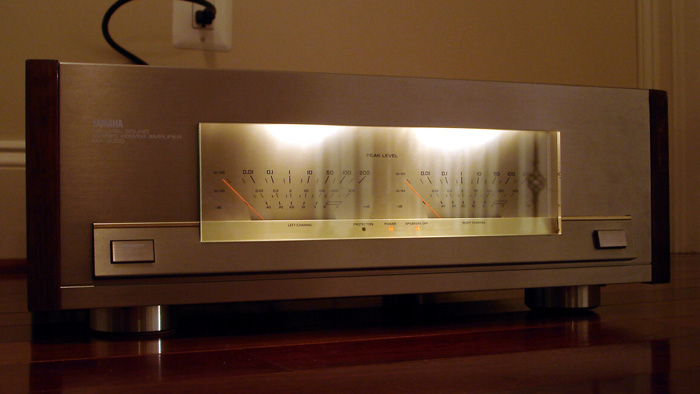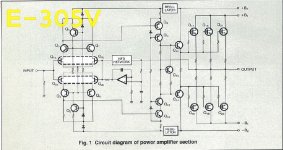As the load impedance is decreased, the proportionate current demand by the load is increased for the a constant decibel magnitude from the loudspeakers, respectively. Thus, as net Power output is increased for higher listening levels, the amplifier moves into Class AB on transients or for the portion that exceeds the quiescent current. That is the key consideration, it would be at high listening levels and does not necessarily imply any sonic degradation. Yamaha and Accuphase share many design similarities and the same components, both of their higher offers being able to drive a lower relative impedance and reactive load.
Last edited:
Really? Which Yamaha model do you mean?Yamaha and Accuphase share many design similarities and the same components
They're not widely known in the audio world. Yamaha made two lines of gear to commemorate its 100th anniversary and the two amps were the Titanium Centennial edition MX-2000 and MX-10000, but the AX-2000 receiver, the tuners, cd players and preamps in these series also contain internals that resemble Accuphase's work to some length. They're 26-27 years old and still look state of the art in and out, like Accuphase did at the same era and both amps can drive 1 ohms. The board layout of each brand was remarkably similar. They sourced their Mosfets, relays and chipsets from the same suppliers. Yamaha, however, used Black Gate and Rubycon capacitors. I often wondered if Yamaha contracted Accuphase to build the chassis and case work to their specifications, as retooling to make two limited edition product lines would have cost a fortune and been unnecessary, while Accuphase Japan could have been already equipped for the metals work. Oh well, its just a guess.Really? Which Yamaha model do you mean?
Below: Accuphase amplifier module.
Below: Yamaha MX-2000 amplifier module.
Below: The chassis underneath is all copper alloy.
An externally hosted image should be here but it was not working when we last tested it.



Even their preamps have internal visual similarities not seen today outside of costly gear.


Last edited:
As the load impedance is decreased, the proportionate current demand by the load is increased for the a constant decibel magnitude from the loudspeakers, respectively. Thus, as net Power output is increased for higher listening levels, the amplifier moves into Class AB on transients or for the portion that exceeds the quiescent current. That is the key consideration, it would be at high listening levels and does not necessarily imply any sonic degradation. Yamaha and Accuphase share many design similarities and the same components, both of their higher offers being able to drive a lower relative impedance and reactive load.
In other words, it is really high bias class AB. I wonder how they linearize the output Gm between large and small transients, and steer clear of Gm doubling at small signal levels.
 I suppose balanced current sharing between the multiple output pairs is important here.
I suppose balanced current sharing between the multiple output pairs is important here.To be politically correct, no. They are fully Class A under the designated definition and operation to a given current limit. The outputs are always on, and some will move out of A operation only at considerably high output levels, others lower. Accuphase builds in a push pull arrangement. Accuphase, Jeff Rowland, Mark Levinson, Coda, Classé, Musical Fidelity, Krell, Fonel, Pass Labs and most other high end brands have made the transition to highly biased push pull amplifiers. Many tube amps touted as class A are actually AB, as we've learned recently. The Class A push pull amp offers the advantage of high current margins when required, lower distortion than single ended, and no crossover transition distortion commonly found in low bias AB output stages. Along with this, the obvious lower consumption and long operating stability.
Last edited:
To be politically correct, no. They are fully Class A under the designated definition and operation to a given current limit.
So, it is class A operation until it reaches the quoted allowable current before the current 'overdrive' limit, and then it is class B operation since one side polarity output transistor turns off. Is this not high bias class AB? Sure it has a large class A operating region but one side polarity turns off at some point during large transients and it is designed to do this. I think there is a bit of marketing going on. Usually that is what it takes to sell 'professional' amps.

Having the class B switching point at large (current) signals does mask the transistion better than typical class AB bias since the intrisic impedances would be much lower at large signal. It's a reasonable comprimise. Nobody wants to run a heater just to listen to tunes, unless you live up in the Great White North.
Last edited:
Oh I know, I've had my share of space heaters. I can't speak for Accuphase or the other manufacturers, although I know these particular Yamaha amplifiers never allow either half to turn off by using a fast variable bias scheme to minimise heat. Bedini did something a bit less complex in their single ended design to lower consumption at low levels.
Last edited:
You may check out this thread as well
http://www.diyaudio.com/forums/solid-state/174468-very-best-amplifier-i-have-ever-heard.html
BTW in case you are looking froward for Class A as an ex owner of Krell FPB monoblocks I might suggest consider some sort of HiEff speakers (full range driver in back loaded horn or line array) + few watts Class A tube gear (parafeed or OTL OCL).
http://www.diyaudio.com/forums/solid-state/174468-very-best-amplifier-i-have-ever-heard.html
BTW in case you are looking froward for Class A as an ex owner of Krell FPB monoblocks I might suggest consider some sort of HiEff speakers (full range driver in back loaded horn or line array) + few watts Class A tube gear (parafeed or OTL OCL).
This one I would like to clone:
This circuit needs two power rails, B2 being higher voltage but much less current like 100mA or so. Those duel J-fets are much more rare today than they use to be.
Thanks, but Goldmund is in heavy B class biased.....
I think people are attracted to class A because they are trained to think it is superior. The special thing class A does is maintain a much better constant output impedance to the load because both halves contribute 360 degrees of the signal and thus greatly reduces the distortion of the output stage. The OPS is where most of the distortion in power amplifier comes from. If you can bias high class AB then there is compromise for efficiency. Also, there are distortion correction techniques that perform the same function for normal bias class AB, auto-bias schemes and such. Although more complex, the results may be surprising especially as far as the trade for efficiency. 'Heaters' may have much simpler electronics but require large power supplies and large heat dissipation and that looks strong, it’s a good sell.
Last edited:
Happy New Year.
Greetings.. I am quite interested on Accuphase of its tank built design. I also heard it is a sweet sounding amp. I had some read especially on intergrated rang but too many models. Which is the preference of all? All spec seems to be quite similar. Most of it with Pre out and Power in. Some have 1 set of speaker out, some have 2. Some have balance out and some don't. Please enlighten me.
Thanks!!
Greetings.. I am quite interested on Accuphase of its tank built design. I also heard it is a sweet sounding amp. I had some read especially on intergrated rang but too many models. Which is the preference of all? All spec seems to be quite similar. Most of it with Pre out and Power in. Some have 1 set of speaker out, some have 2. Some have balance out and some don't. Please enlighten me.
Thanks!!
Hi!
Thanks, but Goldmund is in heavy B class biased.....
What the heck are you talking about? Class B is defined by no current, zero bias, at no signal.
Class AB has some bias at zero signal to avoid crossover distortion.
Class A conducts all the time, having half the current at no signal.
- Status
- This old topic is closed. If you want to reopen this topic, contact a moderator using the "Report Post" button.
- Home
- Amplifiers
- Solid State
- Accuphase amps
